An Analysis of Marketing Principles Used by Starbucks
VerifiedAdded on 2019/12/03
|22
|4909
|158
Report
AI Summary
This report provides a comprehensive analysis of the marketing principles employed by Starbucks, a leading coffee chain. It begins with an introduction to marketing concepts, including the marketing process and marketing orientation. The report then delves into a SWOT analysis of Starbucks, examining its strengths, weaknesses, opportunities, and threats. It also explores the macro and micro environmental factors affecting Starbucks, utilizing PESTLE and Porter's Five Forces models. Furthermore, the report examines Starbucks' market segmentation strategies, targeting approaches, and consumer behavior. It also analyzes the marketing mix elements and positioning strategies, including brand and value positioning, specifically focusing on the introduction of herbal coffee in the European market. The report concludes with a summary of the key findings and recommendations for Starbucks' marketing efforts.
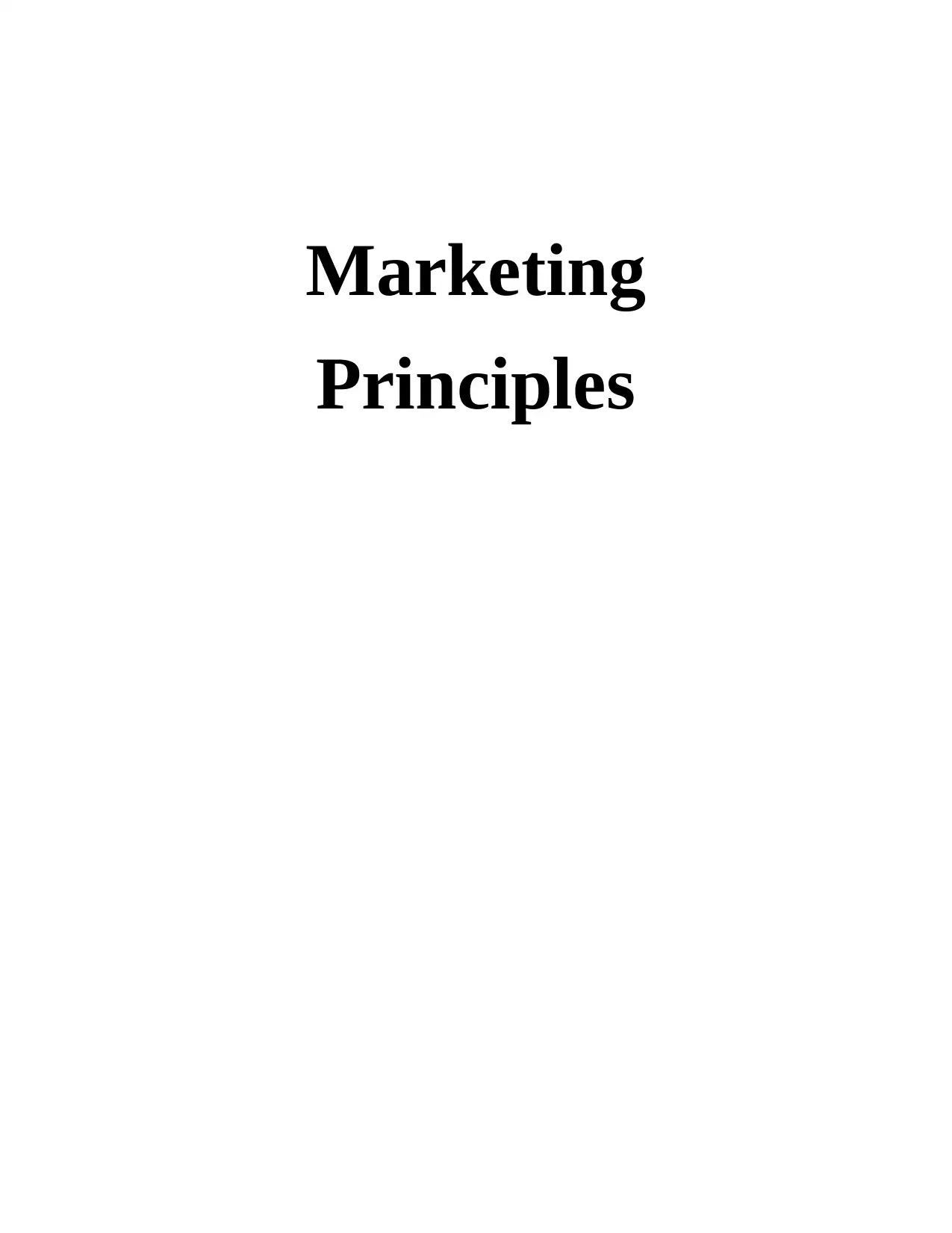
Marketing
Principles
Principles
Paraphrase This Document
Need a fresh take? Get an instant paraphrase of this document with our AI Paraphraser
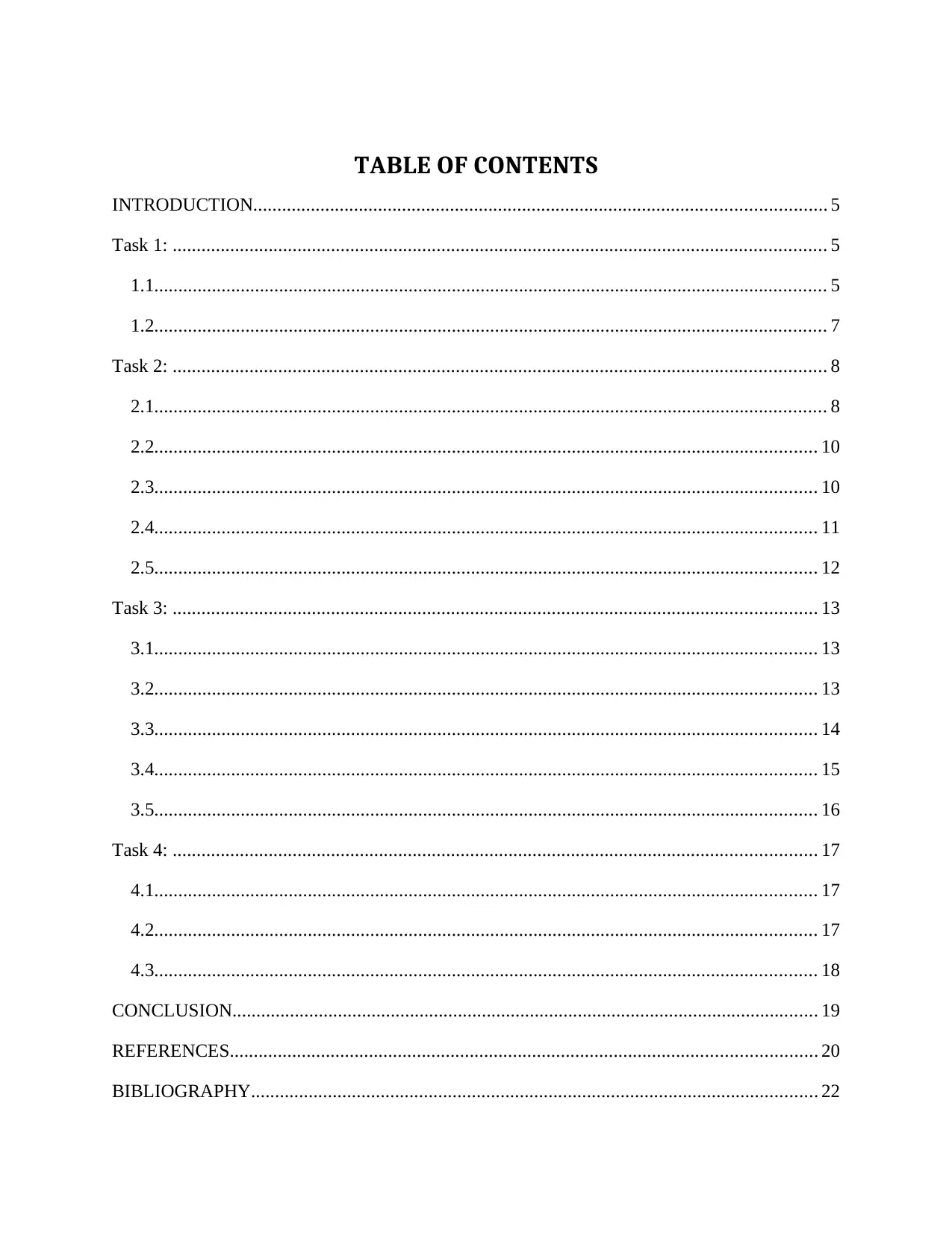
TABLE OF CONTENTS
INTRODUCTION....................................................................................................................... 5
Task 1: ........................................................................................................................................ 5
1.1............................................................................................................................................ 5
1.2............................................................................................................................................ 7
Task 2: ........................................................................................................................................ 8
2.1............................................................................................................................................ 8
2.2.......................................................................................................................................... 10
2.3.......................................................................................................................................... 10
2.4.......................................................................................................................................... 11
2.5.......................................................................................................................................... 12
Task 3: ...................................................................................................................................... 13
3.1.......................................................................................................................................... 13
3.2.......................................................................................................................................... 13
3.3.......................................................................................................................................... 14
3.4.......................................................................................................................................... 15
3.5.......................................................................................................................................... 16
Task 4: ...................................................................................................................................... 17
4.1.......................................................................................................................................... 17
4.2.......................................................................................................................................... 17
4.3.......................................................................................................................................... 18
CONCLUSION.......................................................................................................................... 19
REFERENCES.......................................................................................................................... 20
BIBLIOGRAPHY...................................................................................................................... 22
INTRODUCTION....................................................................................................................... 5
Task 1: ........................................................................................................................................ 5
1.1............................................................................................................................................ 5
1.2............................................................................................................................................ 7
Task 2: ........................................................................................................................................ 8
2.1............................................................................................................................................ 8
2.2.......................................................................................................................................... 10
2.3.......................................................................................................................................... 10
2.4.......................................................................................................................................... 11
2.5.......................................................................................................................................... 12
Task 3: ...................................................................................................................................... 13
3.1.......................................................................................................................................... 13
3.2.......................................................................................................................................... 13
3.3.......................................................................................................................................... 14
3.4.......................................................................................................................................... 15
3.5.......................................................................................................................................... 16
Task 4: ...................................................................................................................................... 17
4.1.......................................................................................................................................... 17
4.2.......................................................................................................................................... 17
4.3.......................................................................................................................................... 18
CONCLUSION.......................................................................................................................... 19
REFERENCES.......................................................................................................................... 20
BIBLIOGRAPHY...................................................................................................................... 22

⊘ This is a preview!⊘
Do you want full access?
Subscribe today to unlock all pages.

Trusted by 1+ million students worldwide
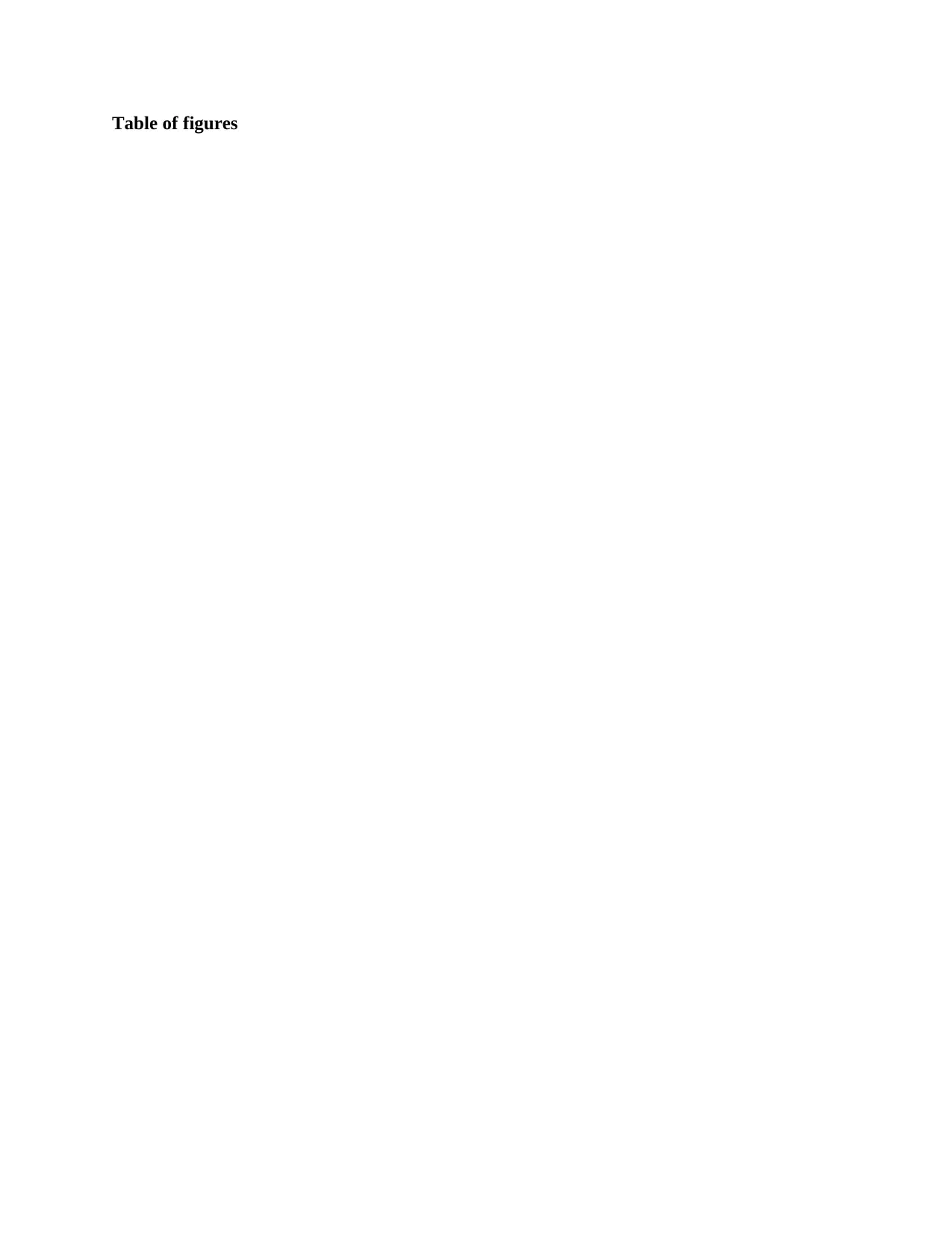
Table of figures
Paraphrase This Document
Need a fresh take? Get an instant paraphrase of this document with our AI Paraphraser
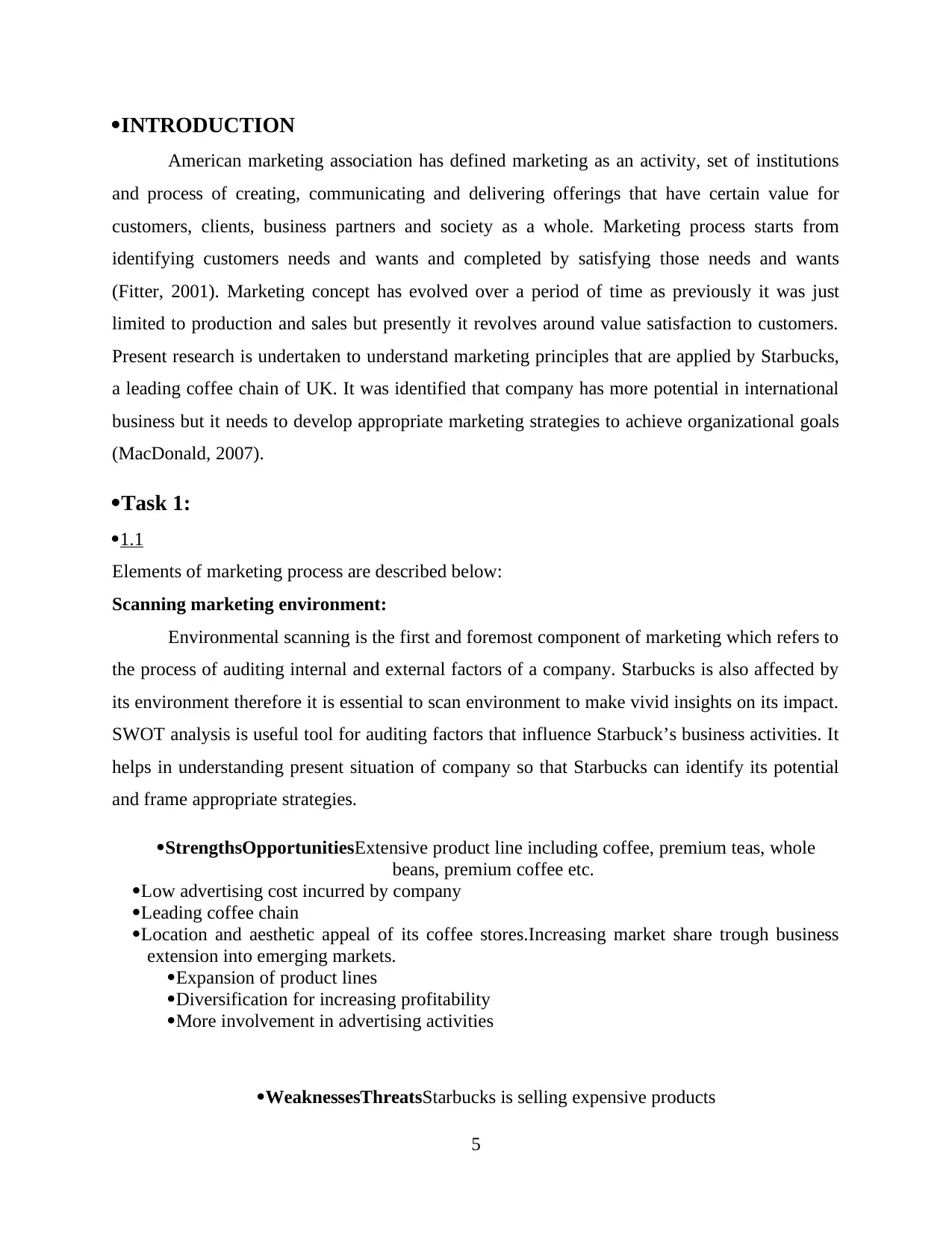
·INTRODUCTION
American marketing association has defined marketing as an activity, set of institutions
and process of creating, communicating and delivering offerings that have certain value for
customers, clients, business partners and society as a whole. Marketing process starts from
identifying customers needs and wants and completed by satisfying those needs and wants
(Fitter, 2001). Marketing concept has evolved over a period of time as previously it was just
limited to production and sales but presently it revolves around value satisfaction to customers.
Present research is undertaken to understand marketing principles that are applied by Starbucks,
a leading coffee chain of UK. It was identified that company has more potential in international
business but it needs to develop appropriate marketing strategies to achieve organizational goals
(MacDonald, 2007).
·Task 1:
·1.1
Elements of marketing process are described below:
Scanning marketing environment:
Environmental scanning is the first and foremost component of marketing which refers to
the process of auditing internal and external factors of a company. Starbucks is also affected by
its environment therefore it is essential to scan environment to make vivid insights on its impact.
SWOT analysis is useful tool for auditing factors that influence Starbuck’s business activities. It
helps in understanding present situation of company so that Starbucks can identify its potential
and frame appropriate strategies.
·StrengthsOpportunitiesExtensive product line including coffee, premium teas, whole
beans, premium coffee etc.
·Low advertising cost incurred by company
·Leading coffee chain
·Location and aesthetic appeal of its coffee stores.Increasing market share trough business
extension into emerging markets.
·Expansion of product lines
·Diversification for increasing profitability
·More involvement in advertising activities
·WeaknessesThreatsStarbucks is selling expensive products
5
American marketing association has defined marketing as an activity, set of institutions
and process of creating, communicating and delivering offerings that have certain value for
customers, clients, business partners and society as a whole. Marketing process starts from
identifying customers needs and wants and completed by satisfying those needs and wants
(Fitter, 2001). Marketing concept has evolved over a period of time as previously it was just
limited to production and sales but presently it revolves around value satisfaction to customers.
Present research is undertaken to understand marketing principles that are applied by Starbucks,
a leading coffee chain of UK. It was identified that company has more potential in international
business but it needs to develop appropriate marketing strategies to achieve organizational goals
(MacDonald, 2007).
·Task 1:
·1.1
Elements of marketing process are described below:
Scanning marketing environment:
Environmental scanning is the first and foremost component of marketing which refers to
the process of auditing internal and external factors of a company. Starbucks is also affected by
its environment therefore it is essential to scan environment to make vivid insights on its impact.
SWOT analysis is useful tool for auditing factors that influence Starbuck’s business activities. It
helps in understanding present situation of company so that Starbucks can identify its potential
and frame appropriate strategies.
·StrengthsOpportunitiesExtensive product line including coffee, premium teas, whole
beans, premium coffee etc.
·Low advertising cost incurred by company
·Leading coffee chain
·Location and aesthetic appeal of its coffee stores.Increasing market share trough business
extension into emerging markets.
·Expansion of product lines
·Diversification for increasing profitability
·More involvement in advertising activities
·WeaknessesThreatsStarbucks is selling expensive products
5
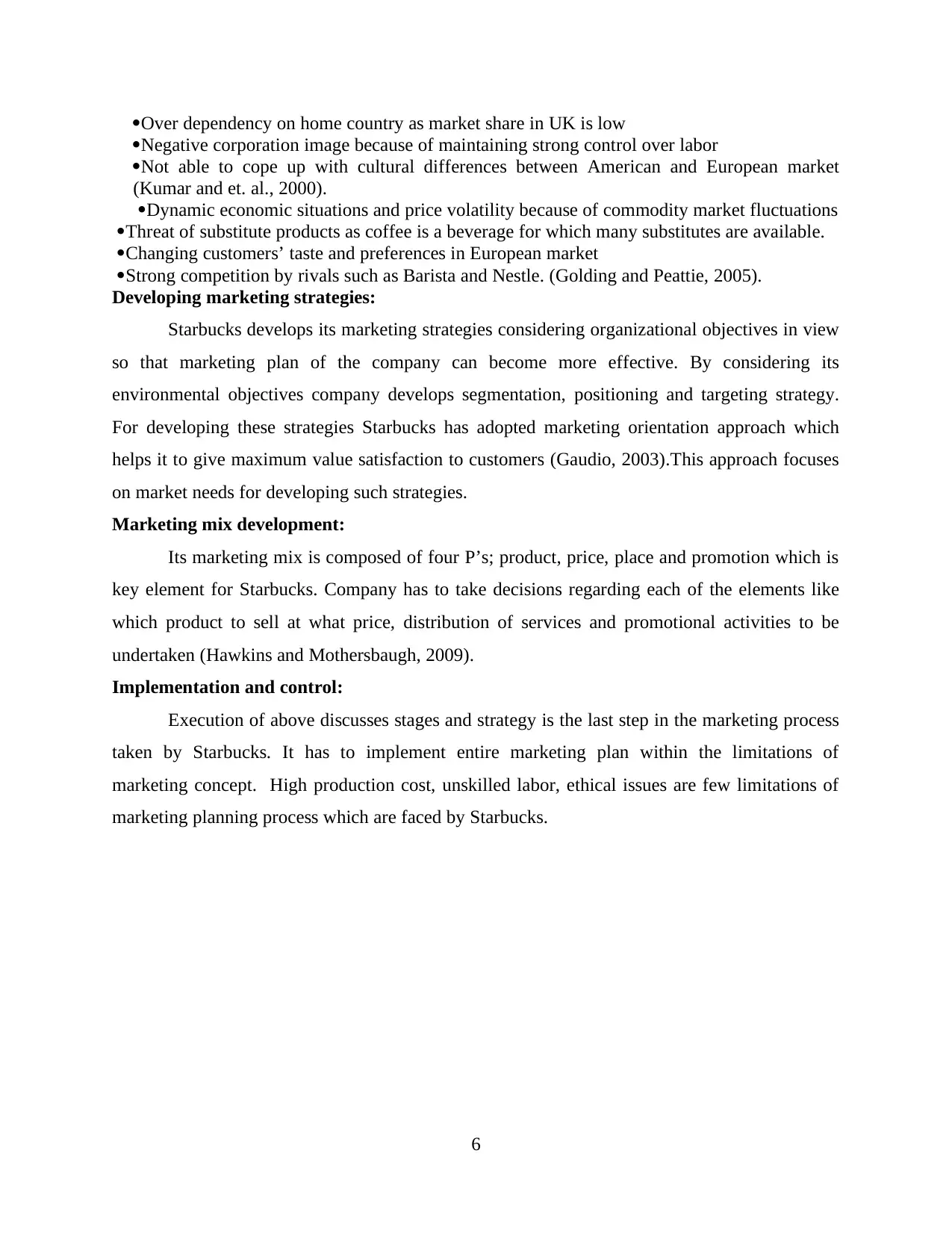
·Over dependency on home country as market share in UK is low
·Negative corporation image because of maintaining strong control over labor
·Not able to cope up with cultural differences between American and European market
(Kumar and et. al., 2000).
·Dynamic economic situations and price volatility because of commodity market fluctuations
·Threat of substitute products as coffee is a beverage for which many substitutes are available.
·Changing customers’ taste and preferences in European market
·Strong competition by rivals such as Barista and Nestle. (Golding and Peattie, 2005).
Developing marketing strategies:
Starbucks develops its marketing strategies considering organizational objectives in view
so that marketing plan of the company can become more effective. By considering its
environmental objectives company develops segmentation, positioning and targeting strategy.
For developing these strategies Starbucks has adopted marketing orientation approach which
helps it to give maximum value satisfaction to customers (Gaudio, 2003).This approach focuses
on market needs for developing such strategies.
Marketing mix development:
Its marketing mix is composed of four P’s; product, price, place and promotion which is
key element for Starbucks. Company has to take decisions regarding each of the elements like
which product to sell at what price, distribution of services and promotional activities to be
undertaken (Hawkins and Mothersbaugh, 2009).
Implementation and control:
Execution of above discusses stages and strategy is the last step in the marketing process
taken by Starbucks. It has to implement entire marketing plan within the limitations of
marketing concept. High production cost, unskilled labor, ethical issues are few limitations of
marketing planning process which are faced by Starbucks.
6
·Negative corporation image because of maintaining strong control over labor
·Not able to cope up with cultural differences between American and European market
(Kumar and et. al., 2000).
·Dynamic economic situations and price volatility because of commodity market fluctuations
·Threat of substitute products as coffee is a beverage for which many substitutes are available.
·Changing customers’ taste and preferences in European market
·Strong competition by rivals such as Barista and Nestle. (Golding and Peattie, 2005).
Developing marketing strategies:
Starbucks develops its marketing strategies considering organizational objectives in view
so that marketing plan of the company can become more effective. By considering its
environmental objectives company develops segmentation, positioning and targeting strategy.
For developing these strategies Starbucks has adopted marketing orientation approach which
helps it to give maximum value satisfaction to customers (Gaudio, 2003).This approach focuses
on market needs for developing such strategies.
Marketing mix development:
Its marketing mix is composed of four P’s; product, price, place and promotion which is
key element for Starbucks. Company has to take decisions regarding each of the elements like
which product to sell at what price, distribution of services and promotional activities to be
undertaken (Hawkins and Mothersbaugh, 2009).
Implementation and control:
Execution of above discusses stages and strategy is the last step in the marketing process
taken by Starbucks. It has to implement entire marketing plan within the limitations of
marketing concept. High production cost, unskilled labor, ethical issues are few limitations of
marketing planning process which are faced by Starbucks.
6
⊘ This is a preview!⊘
Do you want full access?
Subscribe today to unlock all pages.

Trusted by 1+ million students worldwide
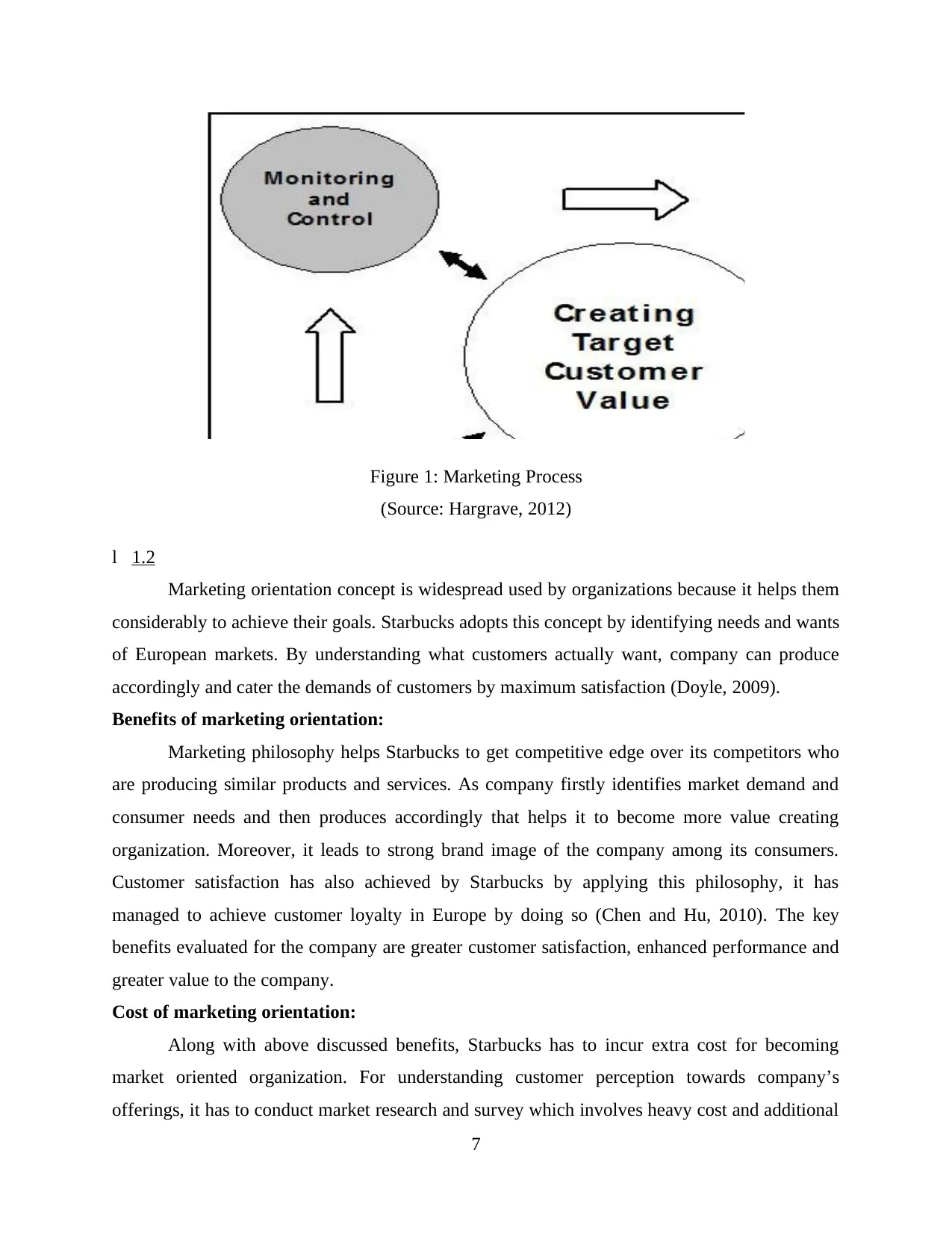
Figure 1: Marketing Process
(Source: Hargrave, 2012)
l壱1.2
Marketing orientation concept is widespread used by organizations because it helps them
considerably to achieve their goals. Starbucks adopts this concept by identifying needs and wants
of European markets. By understanding what customers actually want, company can produce
accordingly and cater the demands of customers by maximum satisfaction (Doyle, 2009).
Benefits of marketing orientation:
Marketing philosophy helps Starbucks to get competitive edge over its competitors who
are producing similar products and services. As company firstly identifies market demand and
consumer needs and then produces accordingly that helps it to become more value creating
organization. Moreover, it leads to strong brand image of the company among its consumers.
Customer satisfaction has also achieved by Starbucks by applying this philosophy, it has
managed to achieve customer loyalty in Europe by doing so (Chen and Hu, 2010). The key
benefits evaluated for the company are greater customer satisfaction, enhanced performance and
greater value to the company.
Cost of marketing orientation:
Along with above discussed benefits, Starbucks has to incur extra cost for becoming
market oriented organization. For understanding customer perception towards company’s
offerings, it has to conduct market research and survey which involves heavy cost and additional
7
(Source: Hargrave, 2012)
l壱1.2
Marketing orientation concept is widespread used by organizations because it helps them
considerably to achieve their goals. Starbucks adopts this concept by identifying needs and wants
of European markets. By understanding what customers actually want, company can produce
accordingly and cater the demands of customers by maximum satisfaction (Doyle, 2009).
Benefits of marketing orientation:
Marketing philosophy helps Starbucks to get competitive edge over its competitors who
are producing similar products and services. As company firstly identifies market demand and
consumer needs and then produces accordingly that helps it to become more value creating
organization. Moreover, it leads to strong brand image of the company among its consumers.
Customer satisfaction has also achieved by Starbucks by applying this philosophy, it has
managed to achieve customer loyalty in Europe by doing so (Chen and Hu, 2010). The key
benefits evaluated for the company are greater customer satisfaction, enhanced performance and
greater value to the company.
Cost of marketing orientation:
Along with above discussed benefits, Starbucks has to incur extra cost for becoming
market oriented organization. For understanding customer perception towards company’s
offerings, it has to conduct market research and survey which involves heavy cost and additional
7
Paraphrase This Document
Need a fresh take? Get an instant paraphrase of this document with our AI Paraphraser
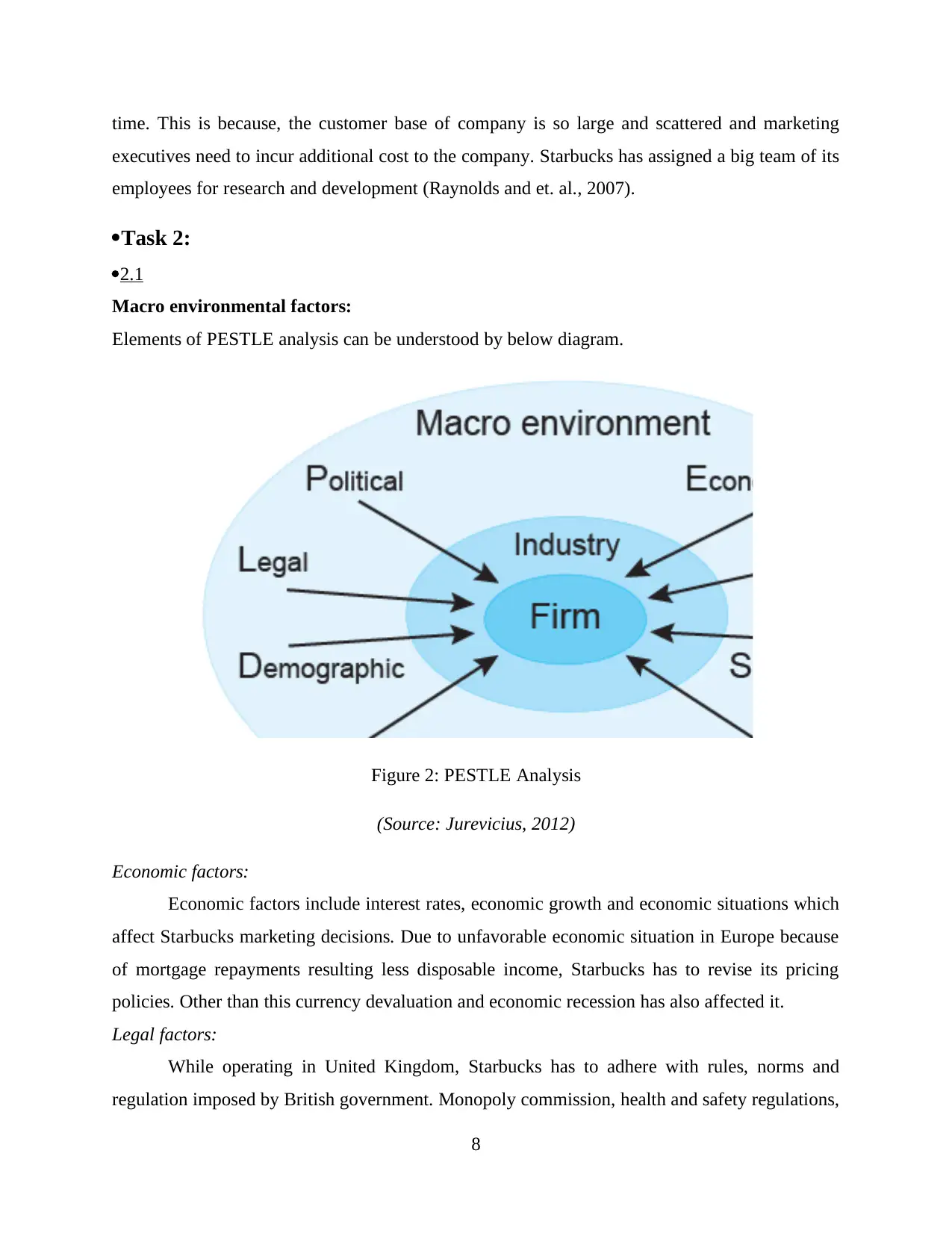
time. This is because, the customer base of company is so large and scattered and marketing
executives need to incur additional cost to the company. Starbucks has assigned a big team of its
employees for research and development (Raynolds and et. al., 2007).
·Task 2:
·2.1
Macro environmental factors:
Elements of PESTLE analysis can be understood by below diagram.
Figure 2: PESTLE Analysis
(Source: Jurevicius, 2012)
Economic factors:
Economic factors include interest rates, economic growth and economic situations which
affect Starbucks marketing decisions. Due to unfavorable economic situation in Europe because
of mortgage repayments resulting less disposable income, Starbucks has to revise its pricing
policies. Other than this currency devaluation and economic recession has also affected it.
Legal factors:
While operating in United Kingdom, Starbucks has to adhere with rules, norms and
regulation imposed by British government. Monopoly commission, health and safety regulations,
8
executives need to incur additional cost to the company. Starbucks has assigned a big team of its
employees for research and development (Raynolds and et. al., 2007).
·Task 2:
·2.1
Macro environmental factors:
Elements of PESTLE analysis can be understood by below diagram.
Figure 2: PESTLE Analysis
(Source: Jurevicius, 2012)
Economic factors:
Economic factors include interest rates, economic growth and economic situations which
affect Starbucks marketing decisions. Due to unfavorable economic situation in Europe because
of mortgage repayments resulting less disposable income, Starbucks has to revise its pricing
policies. Other than this currency devaluation and economic recession has also affected it.
Legal factors:
While operating in United Kingdom, Starbucks has to adhere with rules, norms and
regulation imposed by British government. Monopoly commission, health and safety regulations,
8
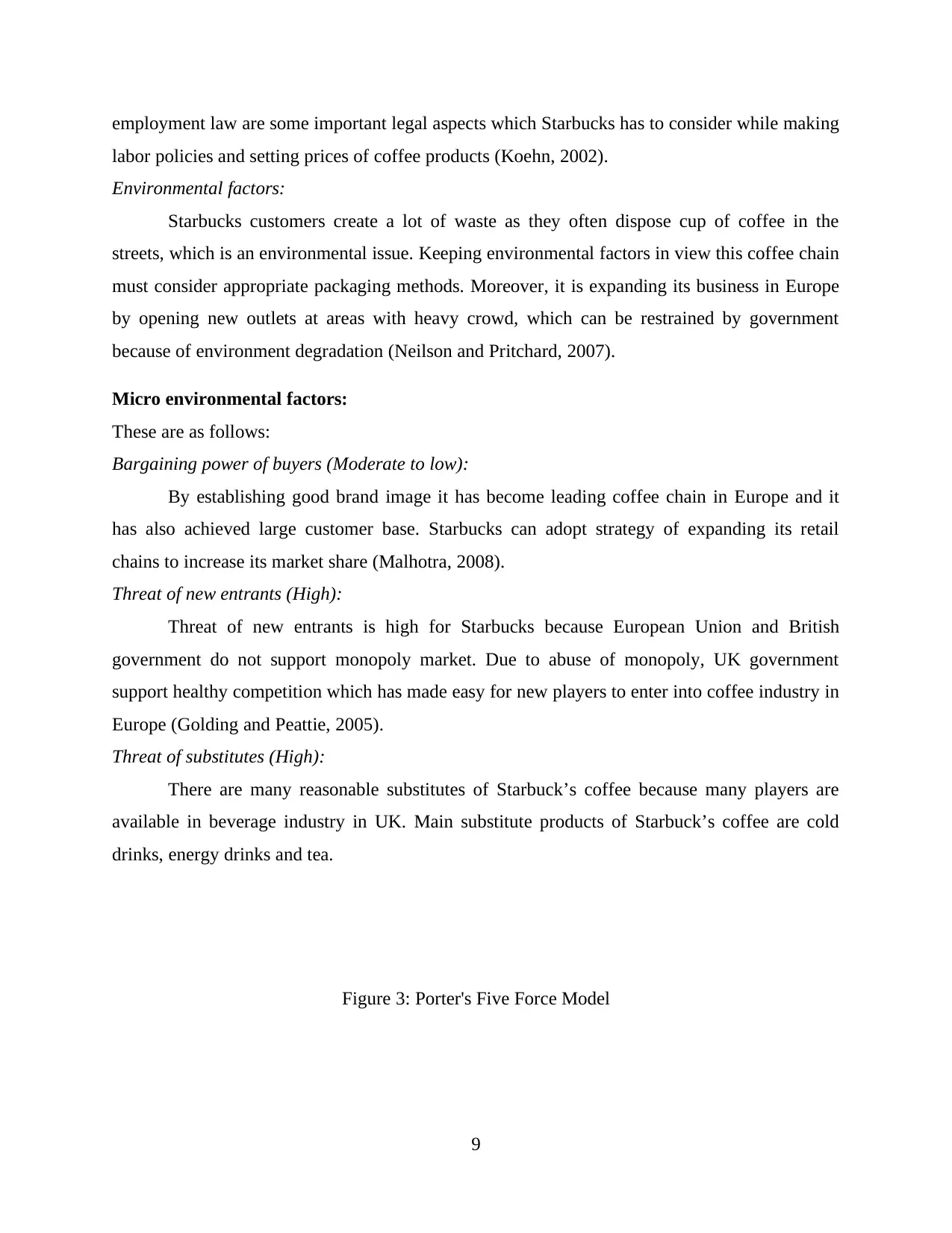
employment law are some important legal aspects which Starbucks has to consider while making
labor policies and setting prices of coffee products (Koehn, 2002).
Environmental factors:
Starbucks customers create a lot of waste as they often dispose cup of coffee in the
streets, which is an environmental issue. Keeping environmental factors in view this coffee chain
must consider appropriate packaging methods. Moreover, it is expanding its business in Europe
by opening new outlets at areas with heavy crowd, which can be restrained by government
because of environment degradation (Neilson and Pritchard, 2007).
Micro environmental factors:
These are as follows:
Bargaining power of buyers (Moderate to low):
By establishing good brand image it has become leading coffee chain in Europe and it
has also achieved large customer base. Starbucks can adopt strategy of expanding its retail
chains to increase its market share (Malhotra, 2008).
Threat of new entrants (High):
Threat of new entrants is high for Starbucks because European Union and British
government do not support monopoly market. Due to abuse of monopoly, UK government
support healthy competition which has made easy for new players to enter into coffee industry in
Europe (Golding and Peattie, 2005).
Threat of substitutes (High):
There are many reasonable substitutes of Starbuck’s coffee because many players are
available in beverage industry in UK. Main substitute products of Starbuck’s coffee are cold
drinks, energy drinks and tea.
Figure 3: Porter's Five Force Model
9
labor policies and setting prices of coffee products (Koehn, 2002).
Environmental factors:
Starbucks customers create a lot of waste as they often dispose cup of coffee in the
streets, which is an environmental issue. Keeping environmental factors in view this coffee chain
must consider appropriate packaging methods. Moreover, it is expanding its business in Europe
by opening new outlets at areas with heavy crowd, which can be restrained by government
because of environment degradation (Neilson and Pritchard, 2007).
Micro environmental factors:
These are as follows:
Bargaining power of buyers (Moderate to low):
By establishing good brand image it has become leading coffee chain in Europe and it
has also achieved large customer base. Starbucks can adopt strategy of expanding its retail
chains to increase its market share (Malhotra, 2008).
Threat of new entrants (High):
Threat of new entrants is high for Starbucks because European Union and British
government do not support monopoly market. Due to abuse of monopoly, UK government
support healthy competition which has made easy for new players to enter into coffee industry in
Europe (Golding and Peattie, 2005).
Threat of substitutes (High):
There are many reasonable substitutes of Starbuck’s coffee because many players are
available in beverage industry in UK. Main substitute products of Starbuck’s coffee are cold
drinks, energy drinks and tea.
Figure 3: Porter's Five Force Model
9
⊘ This is a preview!⊘
Do you want full access?
Subscribe today to unlock all pages.

Trusted by 1+ million students worldwide
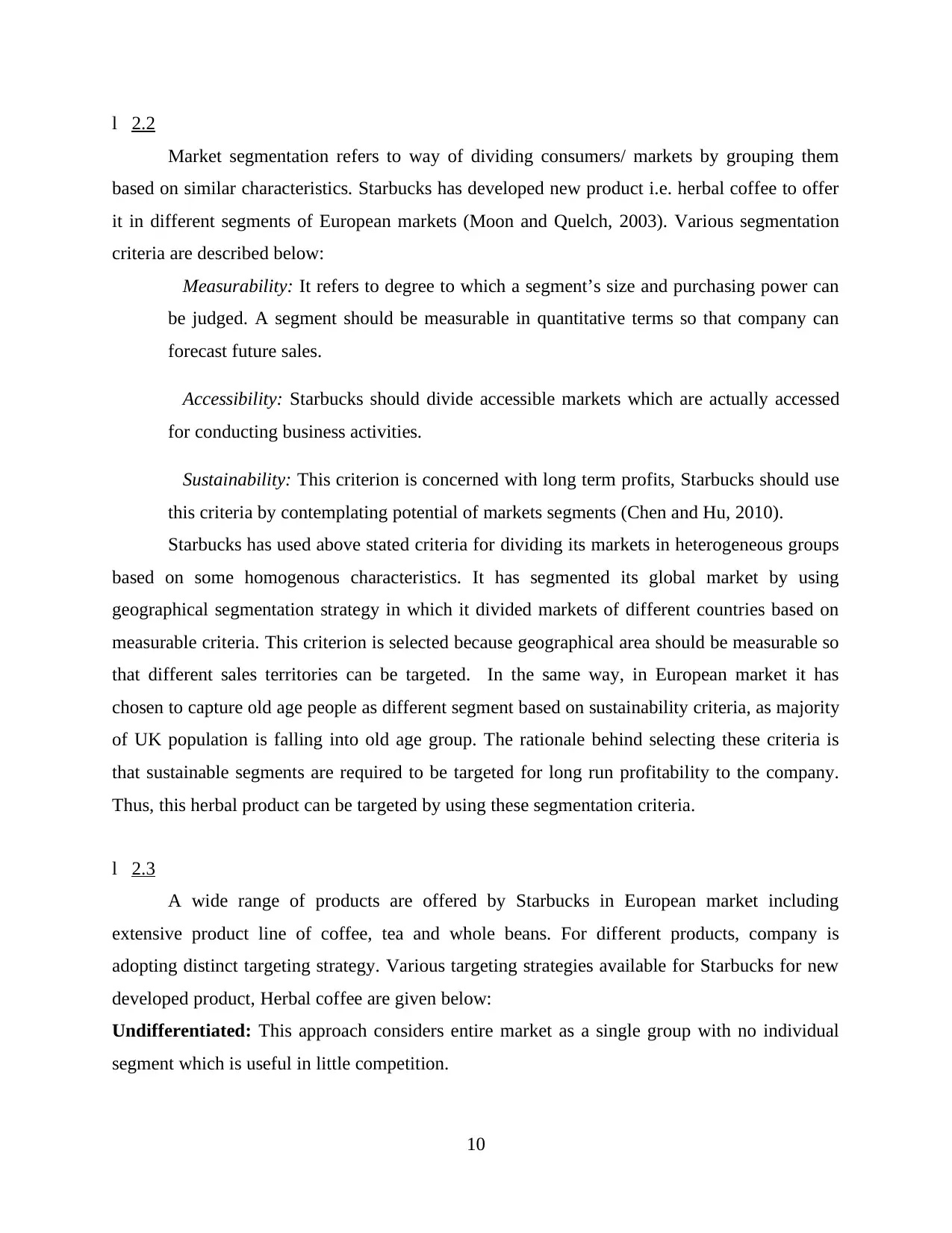
l壱2.2
Market segmentation refers to way of dividing consumers/ markets by grouping them
based on similar characteristics. Starbucks has developed new product i.e. herbal coffee to offer
it in different segments of European markets (Moon and Quelch, 2003). Various segmentation
criteria are described below:
壱Measurability: It refers to degree to which a segment’s size and purchasing power can
be judged. A segment should be measurable in quantitative terms so that company can
forecast future sales.
壱Accessibility: Starbucks should divide accessible markets which are actually accessed
for conducting business activities.
壱Sustainability: This criterion is concerned with long term profits, Starbucks should use
this criteria by contemplating potential of markets segments (Chen and Hu, 2010).
Starbucks has used above stated criteria for dividing its markets in heterogeneous groups
based on some homogenous characteristics. It has segmented its global market by using
geographical segmentation strategy in which it divided markets of different countries based on
measurable criteria. This criterion is selected because geographical area should be measurable so
that different sales territories can be targeted. In the same way, in European market it has
chosen to capture old age people as different segment based on sustainability criteria, as majority
of UK population is falling into old age group. The rationale behind selecting these criteria is
that sustainable segments are required to be targeted for long run profitability to the company.
Thus, this herbal product can be targeted by using these segmentation criteria.
l壱2.3
A wide range of products are offered by Starbucks in European market including
extensive product line of coffee, tea and whole beans. For different products, company is
adopting distinct targeting strategy. Various targeting strategies available for Starbucks for new
developed product, Herbal coffee are given below:
Undifferentiated: This approach considers entire market as a single group with no individual
segment which is useful in little competition.
10
Market segmentation refers to way of dividing consumers/ markets by grouping them
based on similar characteristics. Starbucks has developed new product i.e. herbal coffee to offer
it in different segments of European markets (Moon and Quelch, 2003). Various segmentation
criteria are described below:
壱Measurability: It refers to degree to which a segment’s size and purchasing power can
be judged. A segment should be measurable in quantitative terms so that company can
forecast future sales.
壱Accessibility: Starbucks should divide accessible markets which are actually accessed
for conducting business activities.
壱Sustainability: This criterion is concerned with long term profits, Starbucks should use
this criteria by contemplating potential of markets segments (Chen and Hu, 2010).
Starbucks has used above stated criteria for dividing its markets in heterogeneous groups
based on some homogenous characteristics. It has segmented its global market by using
geographical segmentation strategy in which it divided markets of different countries based on
measurable criteria. This criterion is selected because geographical area should be measurable so
that different sales territories can be targeted. In the same way, in European market it has
chosen to capture old age people as different segment based on sustainability criteria, as majority
of UK population is falling into old age group. The rationale behind selecting these criteria is
that sustainable segments are required to be targeted for long run profitability to the company.
Thus, this herbal product can be targeted by using these segmentation criteria.
l壱2.3
A wide range of products are offered by Starbucks in European market including
extensive product line of coffee, tea and whole beans. For different products, company is
adopting distinct targeting strategy. Various targeting strategies available for Starbucks for new
developed product, Herbal coffee are given below:
Undifferentiated: This approach considers entire market as a single group with no individual
segment which is useful in little competition.
10
Paraphrase This Document
Need a fresh take? Get an instant paraphrase of this document with our AI Paraphraser
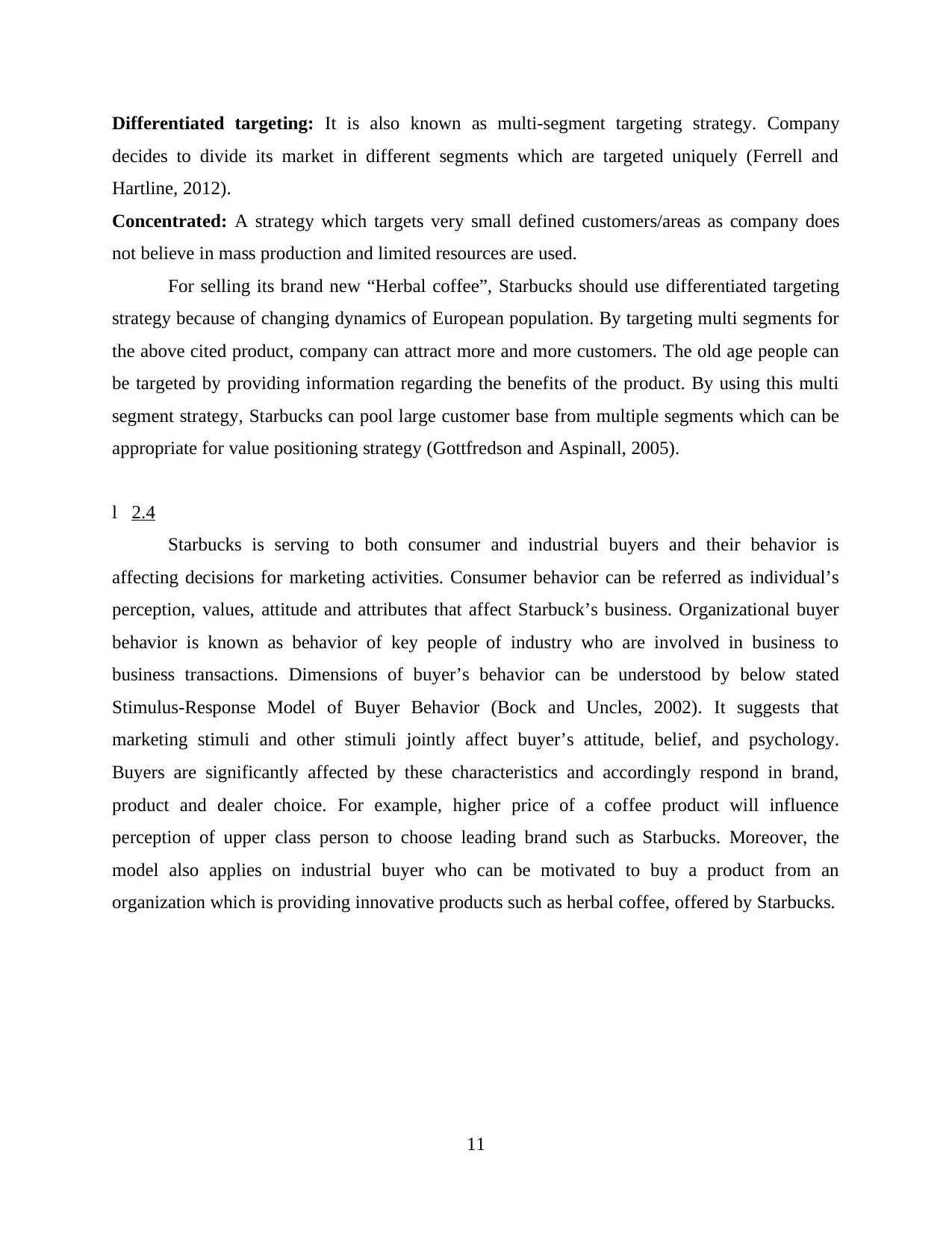
Differentiated targeting: It is also known as multi-segment targeting strategy. Company
decides to divide its market in different segments which are targeted uniquely (Ferrell and
Hartline, 2012).
Concentrated: A strategy which targets very small defined customers/areas as company does
not believe in mass production and limited resources are used.
For selling its brand new “Herbal coffee”, Starbucks should use differentiated targeting
strategy because of changing dynamics of European population. By targeting multi segments for
the above cited product, company can attract more and more customers. The old age people can
be targeted by providing information regarding the benefits of the product. By using this multi
segment strategy, Starbucks can pool large customer base from multiple segments which can be
appropriate for value positioning strategy (Gottfredson and Aspinall, 2005).
l壱2.4
Starbucks is serving to both consumer and industrial buyers and their behavior is
affecting decisions for marketing activities. Consumer behavior can be referred as individual’s
perception, values, attitude and attributes that affect Starbuck’s business. Organizational buyer
behavior is known as behavior of key people of industry who are involved in business to
business transactions. Dimensions of buyer’s behavior can be understood by below stated
Stimulus-Response Model of Buyer Behavior (Bock and Uncles, 2002). It suggests that
marketing stimuli and other stimuli jointly affect buyer’s attitude, belief, and psychology.
Buyers are significantly affected by these characteristics and accordingly respond in brand,
product and dealer choice. For example, higher price of a coffee product will influence
perception of upper class person to choose leading brand such as Starbucks. Moreover, the
model also applies on industrial buyer who can be motivated to buy a product from an
organization which is providing innovative products such as herbal coffee, offered by Starbucks.
11
decides to divide its market in different segments which are targeted uniquely (Ferrell and
Hartline, 2012).
Concentrated: A strategy which targets very small defined customers/areas as company does
not believe in mass production and limited resources are used.
For selling its brand new “Herbal coffee”, Starbucks should use differentiated targeting
strategy because of changing dynamics of European population. By targeting multi segments for
the above cited product, company can attract more and more customers. The old age people can
be targeted by providing information regarding the benefits of the product. By using this multi
segment strategy, Starbucks can pool large customer base from multiple segments which can be
appropriate for value positioning strategy (Gottfredson and Aspinall, 2005).
l壱2.4
Starbucks is serving to both consumer and industrial buyers and their behavior is
affecting decisions for marketing activities. Consumer behavior can be referred as individual’s
perception, values, attitude and attributes that affect Starbuck’s business. Organizational buyer
behavior is known as behavior of key people of industry who are involved in business to
business transactions. Dimensions of buyer’s behavior can be understood by below stated
Stimulus-Response Model of Buyer Behavior (Bock and Uncles, 2002). It suggests that
marketing stimuli and other stimuli jointly affect buyer’s attitude, belief, and psychology.
Buyers are significantly affected by these characteristics and accordingly respond in brand,
product and dealer choice. For example, higher price of a coffee product will influence
perception of upper class person to choose leading brand such as Starbucks. Moreover, the
model also applies on industrial buyer who can be motivated to buy a product from an
organization which is providing innovative products such as herbal coffee, offered by Starbucks.
11
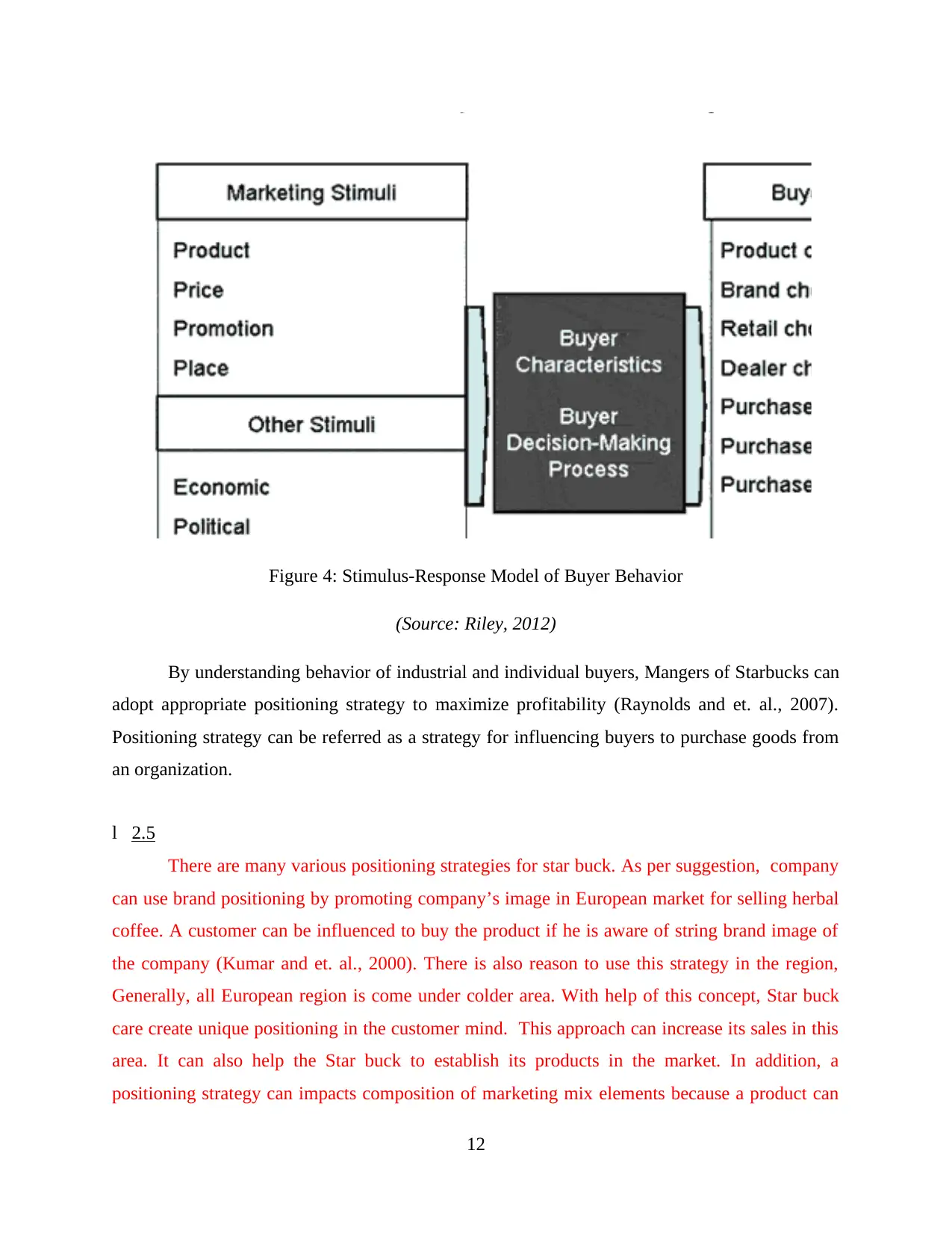
Figure 4: Stimulus-Response Model of Buyer Behavior
(Source: Riley, 2012)
By understanding behavior of industrial and individual buyers, Mangers of Starbucks can
adopt appropriate positioning strategy to maximize profitability (Raynolds and et. al., 2007).
Positioning strategy can be referred as a strategy for influencing buyers to purchase goods from
an organization.
l壱2.5
There are many various positioning strategies for star buck. As per suggestion, company
can use brand positioning by promoting company’s image in European market for selling herbal
coffee. A customer can be influenced to buy the product if he is aware of string brand image of
the company (Kumar and et. al., 2000). There is also reason to use this strategy in the region,
Generally, all European region is come under colder area. With help of this concept, Star buck
care create unique positioning in the customer mind. This approach can increase its sales in this
area. It can also help the Star buck to establish its products in the market. In addition, a
positioning strategy can impacts composition of marketing mix elements because a product can
12
(Source: Riley, 2012)
By understanding behavior of industrial and individual buyers, Mangers of Starbucks can
adopt appropriate positioning strategy to maximize profitability (Raynolds and et. al., 2007).
Positioning strategy can be referred as a strategy for influencing buyers to purchase goods from
an organization.
l壱2.5
There are many various positioning strategies for star buck. As per suggestion, company
can use brand positioning by promoting company’s image in European market for selling herbal
coffee. A customer can be influenced to buy the product if he is aware of string brand image of
the company (Kumar and et. al., 2000). There is also reason to use this strategy in the region,
Generally, all European region is come under colder area. With help of this concept, Star buck
care create unique positioning in the customer mind. This approach can increase its sales in this
area. It can also help the Star buck to establish its products in the market. In addition, a
positioning strategy can impacts composition of marketing mix elements because a product can
12
⊘ This is a preview!⊘
Do you want full access?
Subscribe today to unlock all pages.

Trusted by 1+ million students worldwide
1 out of 22
Related Documents
Your All-in-One AI-Powered Toolkit for Academic Success.
+13062052269
info@desklib.com
Available 24*7 on WhatsApp / Email
![[object Object]](/_next/static/media/star-bottom.7253800d.svg)
Unlock your academic potential
Copyright © 2020–2025 A2Z Services. All Rights Reserved. Developed and managed by ZUCOL.




